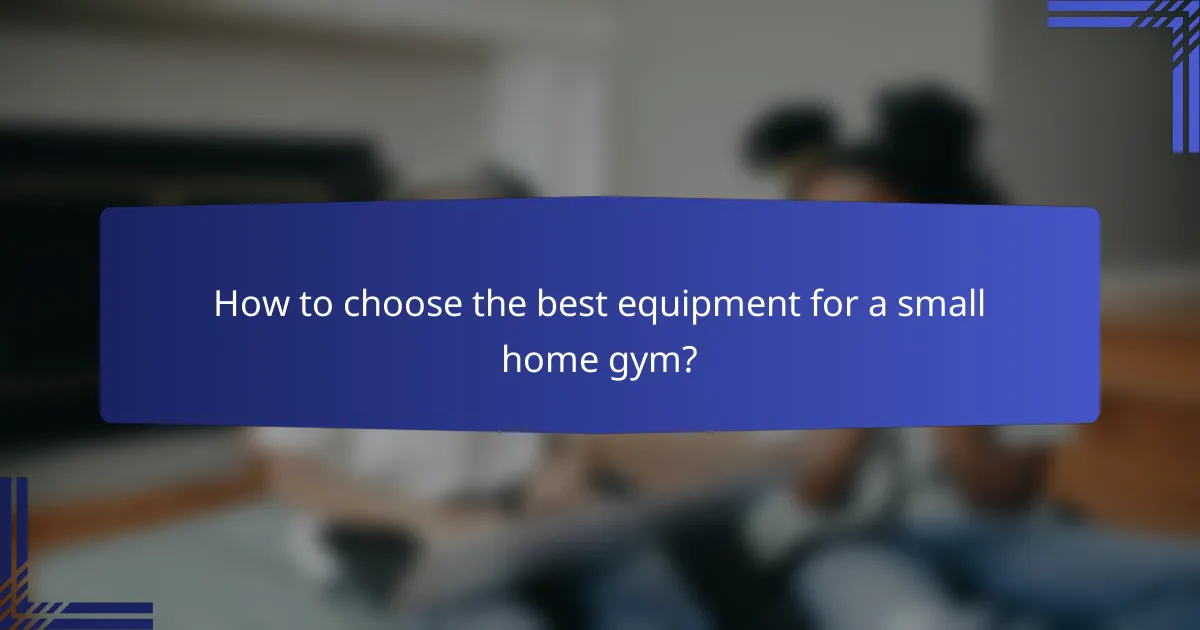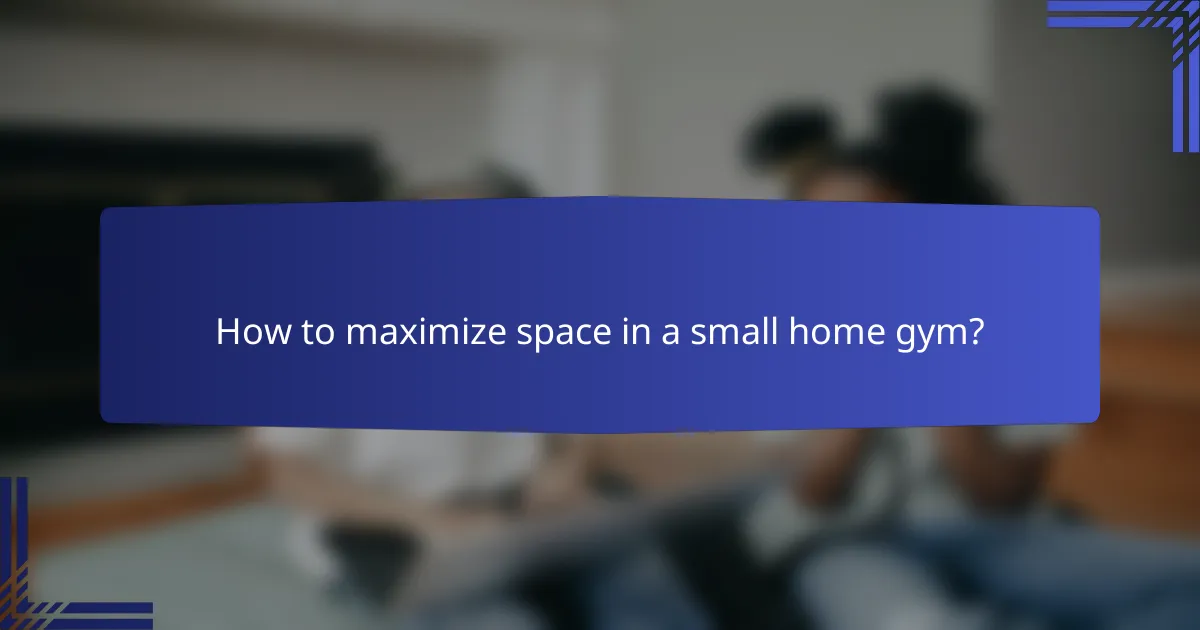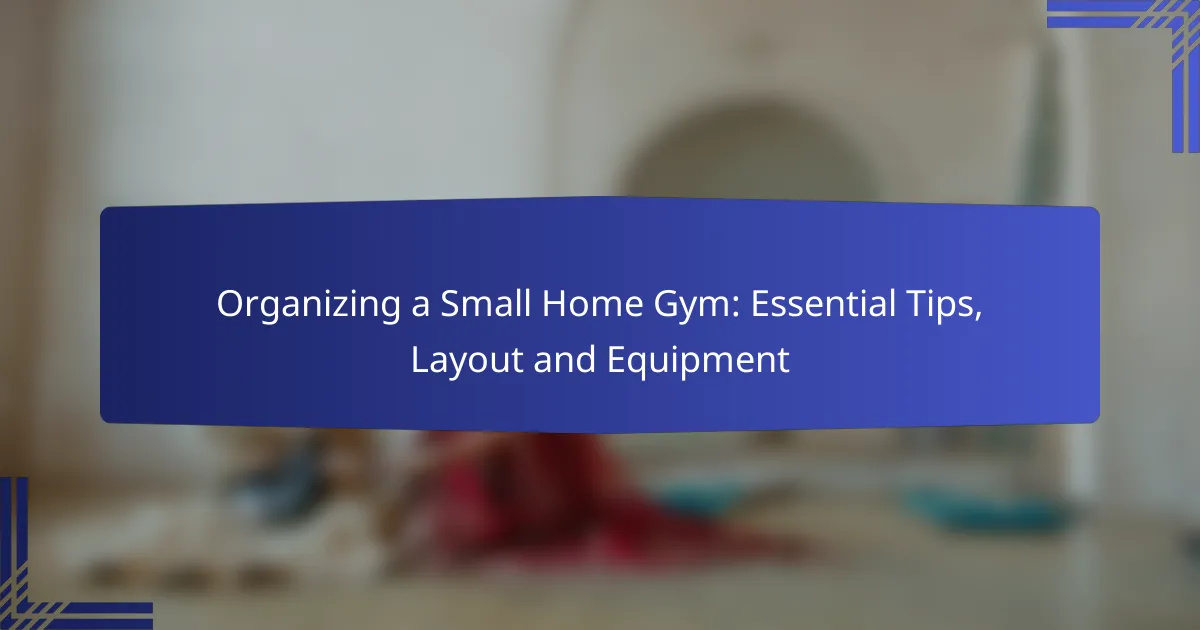Creating a small home gym can be both practical and rewarding, allowing you to stay fit without the need for a large space. By selecting versatile and compact equipment, you can maximize your workout potential while maintaining an organized environment. Thoughtful layout and smart storage solutions will enhance your fitness experience, making it easier to stay motivated and engaged in your routines.

How to choose the best equipment for a small home gym?
Choosing the best equipment for a small home gym involves selecting versatile, compact items that maximize workout potential without taking up excessive space. Focus on multifunctional tools that can cater to various fitness routines while fitting comfortably in your designated area.
Dumbbells for versatile strength training
Dumbbells are essential for strength training, offering a range of weights that can accommodate different fitness levels. Opt for adjustable dumbbells, which allow you to change weights easily, saving space and money while providing a full-body workout.
Consider a weight range of 5 to 50 pounds, as this covers most strength training needs. Look for options with ergonomic grips to enhance comfort during use.
Resistance bands for space-saving workouts
Resistance bands are excellent for small home gyms as they are lightweight and easily stored. They provide resistance for strength training and can be used for various exercises targeting different muscle groups.
Choose bands with varying resistance levels to accommodate different exercises and progressions. They can also be used for stretching and rehabilitation, making them a versatile addition to your gym.
Adjustable benches for multi-use
An adjustable bench is a key piece of equipment that allows for multiple exercises, including bench presses, step-ups, and seated workouts. Look for benches that can incline, decline, and lay flat to maximize workout options.
Ensure the bench is sturdy and can support your weight safely. A compact design will help it fit into smaller spaces without compromising functionality.
Compact cardio machines like the Peloton Bike
Compact cardio machines, such as the Peloton Bike, provide an effective way to incorporate cardiovascular workouts into your routine without requiring much space. These machines often come with built-in technology for tracking performance and accessing a variety of classes.
When selecting a cardio machine, consider your available space and the type of workouts you enjoy. Look for foldable or smaller models that can be easily stored when not in use.
Storage solutions for small spaces
Efficient storage solutions are crucial for maintaining an organized small home gym. Utilize vertical space with wall-mounted racks or shelves to store weights, bands, and other equipment off the floor.
Consider multi-functional furniture, such as benches with built-in storage, to keep your gym tidy. Regularly assess your equipment and remove items that are rarely used to maximize your workout area.

What layout works best for a small home gym?
The best layout for a small home gym maximizes space while providing a functional and motivating environment. An effective design incorporates flexibility, dedicated workout zones, and smart storage solutions to accommodate various fitness activities.
Open floor plan for flexibility
An open floor plan allows for versatile workout options and easy movement between different exercises. This layout is ideal for small spaces, as it eliminates barriers and creates a more inviting atmosphere.
Consider using lightweight, movable equipment like resistance bands, dumbbells, and mats that can be easily rearranged. This flexibility enables you to switch between cardio, strength training, and stretching without feeling cramped.
Dedicated zones for different workouts
Creating dedicated zones for specific workouts can enhance focus and efficiency. Designate areas for cardio, strength training, and flexibility exercises to streamline your routine.
For instance, set up a corner with a treadmill or stationary bike for cardio, while another area can house weights and benches for strength training. This organization helps you transition smoothly between workouts and keeps your space tidy.
Utilizing vertical space for storage
Maximizing vertical space is crucial in a small home gym, as it frees up floor area for workouts. Use wall-mounted shelves, hooks, or racks to store equipment like kettlebells, yoga mats, and resistance bands.
Consider installing a pegboard for easy access to smaller items and a wall-mounted rack for larger equipment. This approach not only keeps your gym organized but also adds a visually appealing element to your space.

How to maximize space in a small home gym?
To maximize space in a small home gym, focus on using versatile equipment and smart storage solutions. Prioritize items that serve multiple functions and consider vertical space for storage to keep the area organized and efficient.
Multi-functional equipment to save space
Investing in multi-functional equipment is crucial for small home gyms. Look for items like adjustable dumbbells, which can replace an entire set, or a power tower that allows for various exercises like pull-ups, dips, and push-ups. These versatile tools help you perform a wide range of workouts without taking up much floor space.
Another great option is a bench that can be adjusted for different exercises, such as incline, decline, and flat positions. This adaptability means you can perform various strength training routines using just one piece of equipment.
Wall-mounted storage options
Wall-mounted storage solutions can significantly enhance the organization of your small gym. Consider installing shelves or racks to hold weights, resistance bands, and other accessories off the floor. This keeps your workout area tidy and maximizes available space.
Additionally, pegboards can be a practical choice for hanging items like jump ropes and yoga mats. They allow for easy access while keeping your equipment visible and organized, making it simpler to grab what you need during workouts.
Foldable equipment for easy storage
Foldable equipment is an excellent choice for small home gyms, as it allows for easy storage when not in use. Look for foldable treadmills, exercise bikes, or benches that can be compactly stored in a closet or against a wall.
When selecting foldable items, ensure they are sturdy and easy to set up. Many modern options are designed for quick assembly and disassembly, making it convenient to transition between workouts and storage. This flexibility helps maintain a clutter-free environment while still providing the equipment you need for effective training.

What are the essential tips for organizing a home gym?
To effectively organize a home gym, focus on accessibility, cleanliness, and motivation. A well-structured space enhances your workout experience and encourages consistency.
Keep equipment accessible and tidy
Ensuring that your gym equipment is easily accessible is crucial for a smooth workout routine. Store frequently used items, like dumbbells and resistance bands, within arm’s reach, while less-used equipment can be stored in cabinets or on shelves.
Regularly tidy up your space to avoid clutter, which can be distracting. Consider using storage solutions like racks or bins to keep everything organized and in its designated place.
Use labels for organization
Labeling storage areas can significantly enhance organization in your home gym. Use clear, visible labels on bins and shelves to indicate where each piece of equipment belongs, making it easier to find and return items after use.
Labels can also help family members or roommates understand the layout of your gym, promoting shared responsibility for keeping the space organized. Simple, bold labels can be made with a label maker or printed out for a professional look.
Incorporate mirrors for motivation
Mirrors can play a vital role in your home gym by providing motivation and helping with form during exercises. Position mirrors where you can see your reflection while working out to ensure you maintain proper technique.
Additionally, mirrors can create an illusion of a larger space, making your gym feel more open and inviting. Consider wall-mounted mirrors or full-length options that fit your available wall space.

How to create a motivating environment in a small gym?
Creating a motivating environment in a small gym involves optimizing the space with elements that inspire and energize you. Focus on lighting, personal touches, and sound systems to enhance your workout experience and keep you engaged.
Lighting options to enhance mood
Effective lighting can significantly impact your motivation and energy levels while exercising. Consider using a combination of natural light, overhead fixtures, and adjustable LED lights to create a bright and inviting atmosphere.
Warm white lights can promote relaxation, while cooler tones can energize you. Installing dimmable lights allows you to adjust the ambiance based on your workout type, whether it’s a calming yoga session or an intense cardio routine.
Incorporating personal touches like artwork
Adding personal touches, such as artwork or motivational quotes, can make your small gym feel more inviting and inspiring. Choose pieces that resonate with you, whether they are images of athletes, landscapes, or abstract designs.
Consider creating a gallery wall or using removable decals to personalize your space without permanent alterations. This not only enhances the aesthetic but also serves as a daily reminder of your fitness goals.
Sound systems for an energizing atmosphere
A quality sound system can elevate your workout experience by providing energizing music or motivational podcasts. Invest in Bluetooth speakers or a soundbar that fits your space and delivers clear audio without taking up too much room.
Curate playlists that match your workout intensity and keep you motivated. Avoid distractions by ensuring your sound system is easy to operate, allowing you to focus on your exercises rather than fiddling with controls.

What are the best flooring options for a home gym?
The best flooring options for a home gym prioritize durability, safety, and comfort. Popular choices include rubber, foam, and vinyl, each offering unique benefits suited to different workout styles and preferences.
Rubber flooring for durability
Rubber flooring is a top choice for home gyms due to its exceptional durability and shock absorption. It can withstand heavy weights and high-impact exercises, making it ideal for weightlifting and cardio workouts.
When selecting rubber flooring, consider thickness and density. Thicker options (around 1/2 inch or more) provide better cushioning and sound insulation, while denser materials resist wear and tear. Look for interlocking tiles or rolls for easier installation and maintenance.
While rubber flooring can be more expensive than other options, its longevity often justifies the investment. Avoid cheaper alternatives that may wear out quickly or emit unpleasant odors, and ensure proper ventilation during installation to minimize any off-gassing.
